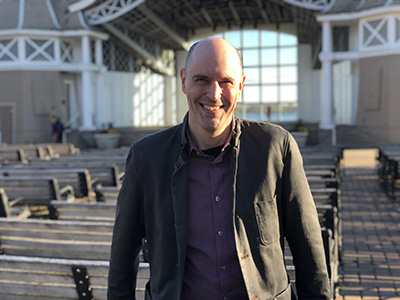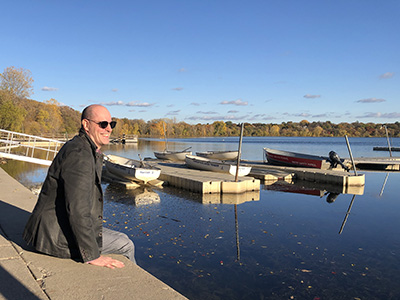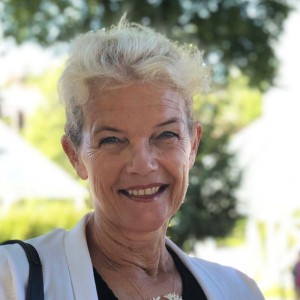Brian Rowe uses tactics he learned in the Organization Development Certificate program to influence human-centered systems design at Blue Cross and Blue Shield of Minnesota
Brian Rowe has a head for complex systems, which Merriam-Webster describes as regularly interacting or interdependent groups of items forming a unified whole. After working as a software developer in a variety of industries, he became interested in what is commonly referred to as “user experience."
“Consumer experience. Service design. In my mind, they’re really just modern facets of awareness of complex systems,” says Rowe. “Human systems are complex systems.” Software development eventually led him into managing a team of user experience designers at a small software development shop. After a few years, the company reorganized and let go of all their managers, and Rowe found himself looking for something new and challenging.
Influencing Habits and Behaviors
During his job search, he took advantage of the state of Minnesota’s Dislocated Worker (DW) services, which provides funds for people to take advantage of adult learner programs or retraining. His case worker pointed him to the College of Continuing and Professional Studies.
“I was looking at some things like futurist studies, or complexity and systems-thinking studies, stuff like that, when I discovered the Organization Development program,” Rowe says. “I was fascinated with the overlap between these very rigorously human-centered problem solving practices I had been exploring and the idea of redesigning and rethinking organizations. I had some hypotheses in my mind of what that kind of thing could look like in my previous work at the sand-box level. But I wanted to see what was being done in larger, more complex organizations, in terms of designing workspaces and org structures, and influencing habits and behaviors that align better with the human beings actually doing the things.”
Rowe’s DW advisor acted as a liaison with CCAPS, helping Rowe with the registration process, making sure the funds were in order, and checking in throughout the program to track his progress. While completing the certificate program, Rowe went to work for Blue Cross and Blue Shield of Minnesota as a customer experience architect. His next job was heading up a small team of employee experience designers and researchers at Best Buy. From there, he was recruited back to Blue Cross as a principal strategy consultant, where he acts as a collaborative “thought partner” to introduce different human-centered design frameworks, methods, and mindsets to help evolve a team’s thinking and ways of doing things.
Impact Mapping
Rowe describes human-centered design practice as getting outside your head, invalidating one’s assumptions, using empathy to help better understand another person’s true needs, and co-creating with those you’re trying to support. “It’s about building a shared understanding of the kinds of problems we’re grappling with at any point in time, such as reducing barriers to diabetes care or discovering how to better support caregivers. Getting different points of view and perceptions out in a space where we can see them and react to them and build a shared understanding and help inform that shared understanding. And applying deep empathy to understand the true needs of those whom you’re trying to do something for. Being in a constant, adaptive learning mode. The only way I can summarize that in three words is inquire, sense, pivot.”
One of the tools he learned in the Successfully Lead Enterprise-Wide Change Management course and uses in his current role is impact mapping, which Rowe says is a simple tool that helps you see the path to what you’re trying to accomplish.
“There are four dimensions to it. You start with the high-level impact that the organization is trying to chase. Think of the most senior-level leadership and some big impact metrics they’re concerned with. The second piece is some sort of results proposition or problem value. Something a team could actually do something about, such as improve a website experience so the rates of people using it—filling out online forms, for example—increase or error rates decrease. Thirdly, it’s the actions. What are people going to do? What are the behaviors that will lead to those top-line goals?
"The critical last part is capabilities. What don’t they have today to do those things and to see those results to hit those bigger impacts? That might be talent or technology or training or tools or money. And that’s where you might target an intervention. Maybe we need to rework the way some groups are collaborating or find a way to skill up some of the talent or support them differently and maybe we need some sort of technological levers to enable platforms for what they need to do. So now they’re better equipped to do those things that we outlined to see those results. That’s the impact map. You start at the end goal and you work back.”
A New Way to Work
Rowe says the Organization Development Certificate program offered a lot of opportunities for group discussion, collaboration, and deep thinking about how to approach different situations. “I really appreciated that the instructor actually developed a lot of those case studies based on her real-world practice as an OD consultant and expert. You know the names are made up but the problems are real, right? Because of the OD training, I have a new way to align human-centered practices with a more clearly-targeted organizational need.”
Visit the Organization Development Certificate website for more information about the program.









